华侨大学849旅游经济学2016-2017年考研专业课真题试卷
- 格式:pdf
- 大小:393.71 KB
- 文档页数:5
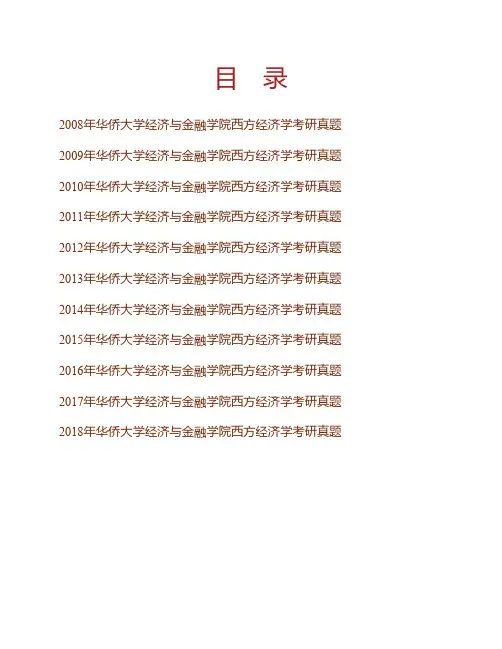
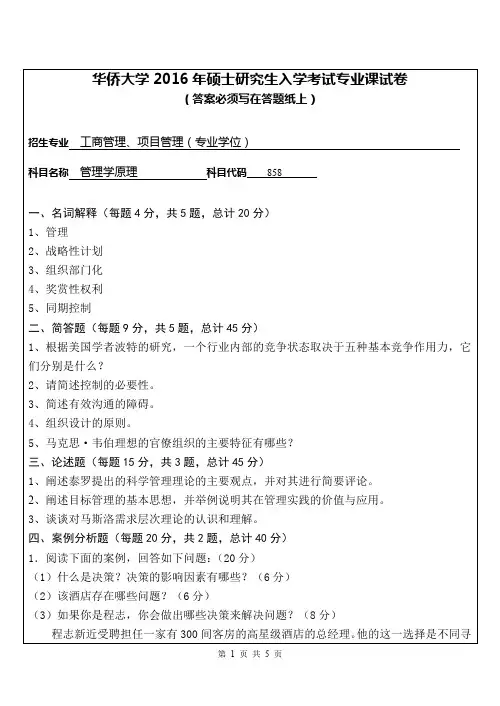
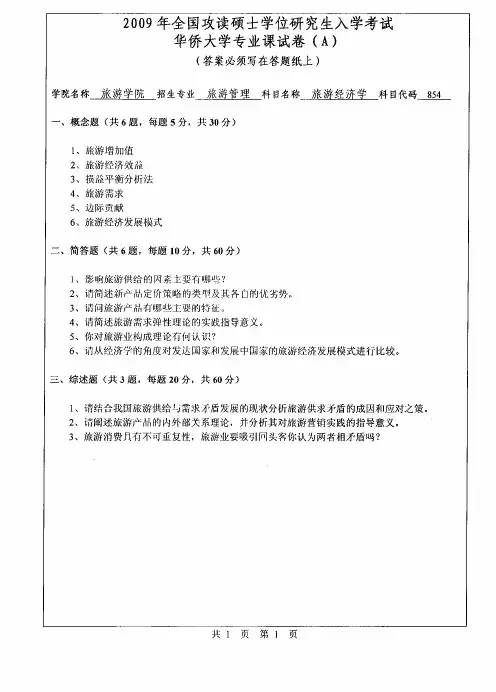
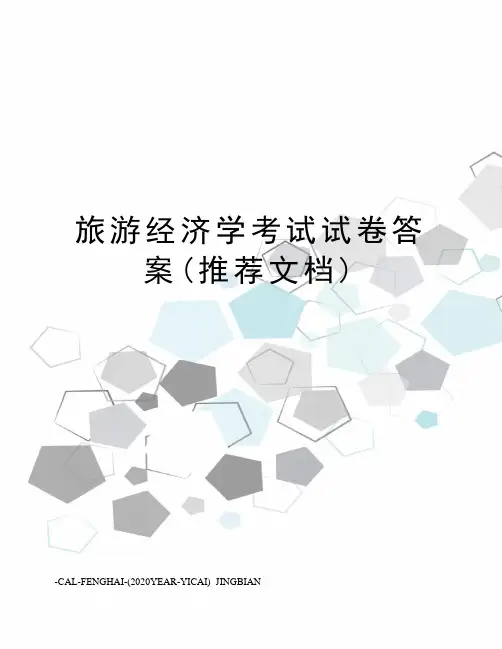
旅游经济学考试试卷答案(推荐文档)-CAL-FENGHAI-(2020YEAR-YICAI)_JINGBIAN旅游经济学试卷一、填空题(每空1分共10分)生产__ ___分配__ __交换__和__消费___是社会再生产的四个相互联系的坏节,生产是这个过程的起点,消费是这个过程的终点。
2.旅游包括_旅行____和 ___游览__两个方面。
3.旅游消费作为一种个人消费,从内容上来看包括___物质消费__和_精神消费____两方面。
4.旅游产业的生命周期分为:孕育期__成长期___ _成熟期____和衰退期。
二、单项选择题(在每小题的四个备选答案中,选出一个正确答案,并将正确答案的序号填在题干的括号内。
每小题1分,共30分)1.旅游业属于( C )。
A.第一产业B.第二产业C.第三产业D.信息产业2.旅游饭店和旅行社的关系是( B )。
A.包容关系B.互补关系C.转化关系D.互代关系3.在现实经济社会中,最为常见的竞争形式是( D )。
A.寡头竞争B.完全垄断C.垄断竞争D.完全竞争4.旅游能使参与者提高素质,陶冶情操,这是一种( D )。
A.宏观消费效果B.直接消费效果C.经济消费效果D.间接消费效果5.当旅游需求价格弹性系数小于1时,从旅游价格方面分析,要增加旅游收入,不宜采用( A )策略。
A.提价B.降价C.保持不变D.提价或降价均可6.国内旅游能够起到的作用是( C )A.回笼货币B.增加外汇C.增加产值D.国际交往7.旅游产品的核心内容是(B)A.旅游设施B.旅游资源C.旅游服务D.旅游人员8.下列产品中,属于替代关系的是(D)A.旅游饭店与旅游交通B.旅游产品与高档用品C.旅游交通与旅游服务D.旅游设施与旅游服务9.关于需求价格弹性的叙述,正确的是( B )A.旅游产品一般弹性小B.奢侈品一般弹性小C.文化产品一般弹性小D.必需品一般弹性小10.旅游市场一般属于( A )A.完全竞争市场B.完全垄断市场C.垄断竞争市场D.寡头垄断市场11.乘数理论最早是由(B)A.中国经济学家提出来的B.英国经济学家提出来的C.法国经济学家提出来的D.美国经济学家提出来的12.在其他因素不变的前提下,人们在一定时期内对旅游产品的需求量会随着旅游产品价格的升降而呈现___________的变化。
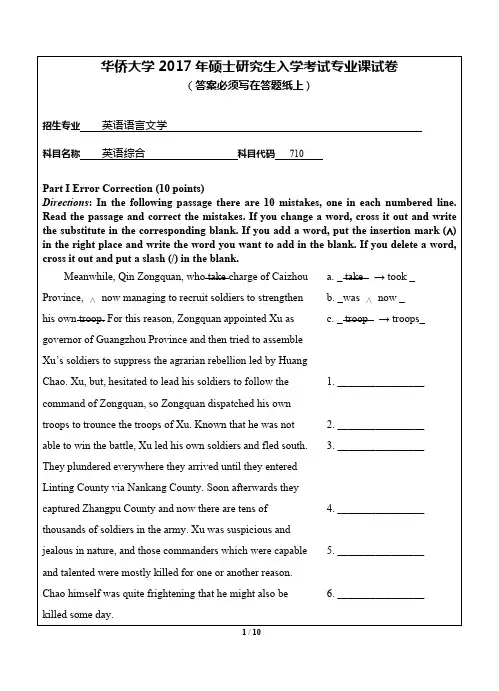
华侨大学2017年硕士研究生入学考试专业课试卷(答案必须写在答题纸上)招生专业英语语言文学科目名称英语综合科目代码710Part I Error Correction (10 points)Directions: In the following passage there are 10 mistakes, one in each numbered line. Read the passage and correct the mistakes. If you change a word, cross it out and write the substitute in the corresponding blank. If you add a word, put the insertion mark (∧) in the right place and write the word you want to add in the blank. If you delete a word, cross it out and put a slash (/) in the blank.Meanwhile, Qin Zongquan, who take charge of Caizhou a. _ take → took _ Province, ∧now managing to recruit soldiers to strengthen b. _was ∧now _his own troop. For this reason, Zongquan appointed Xu as c. _ troop → troops_ governor of Guangzhou Province and then tried to assembleXu’s soldiers to suppress the agrarian rebellion led by HuangChao. Xu, but, hesitated to lead his soldiers to follow the 1. ________________ command of Zongquan, so Zongquan dispatched his owntroops to trounce the troops of Xu. Known that he was not 2. ________________able to win the battle, Xu led his own soldiers and fled south. 3. ________________They plundered everywhere they arrived until they enteredLinting County via Nankang County. Soon afterwards theycaptured Zhangpu County and now there are tens of 4. ________________ thousands of soldiers in the army. Xu was suspicious andjealous in nature, and those commanders which were capable 5. ________________and talented were mostly killed for one or another reason.Chao himself was quite frightening that he might also be 6. ________________killed some day.When the troops arrived Nan’an County, Chao 7. _______________ persuaded his own forward commander to start rebel 8. _______________ against Xu. Chao said, ‘It is because of the threat underXu that we abandoned our ancestral tombs and wives andchildren to come over here to be thefts and robbers. It isagainst own will. Now Xu was sceptical and suspicious,and capable commanders and talented officers were sure to 9. _______________be killed. Every one of us cannot guarantee one’s own safetyeven for a single day, let alone achieve any success!’The forward commander was thoroughly disillusioned byChao. They looked into each other’s eyes and burst into tears.Soon afterwards, Chao and his forward commander selecteddozens of vigorous soldiers to ambush Xu among the bambooforest. These soldiers awaited Xu’s pass by and then jumped 10. _______________out from the forest to capture him. Xu was then imprisoned.Part II Grammar (30 points)(I) There are ten sentences in this section. Beneath each sentence there are four words or phrases marked A, B, C, and D. Choose the word or phrase that best completes the sentence. (10 points)1. He ought to dismiss the unqualified employees under his supervision, ________?A. should heB. ought heC. shouldn’t heD. oughtn’t he2. Sid spends as much time working as he ________.A. travels C. is travellingB. does travelling D. has been travelling3. My deskmate is a reserved person who seldom speaks to me. The underlined part means ________.A. talkativeB. considerateC. quietD. outgoing4. Some English words have no exact ________ in Chinese.A. equivalentsB. equitiesC. equalsD. equalities5. When Columbus embarked ________ his historic voyage, he never imagined that the world history would enter into a new era.A. uponB. inC. atD. to6. It is ________ stealing to take a thing away without permission of its owner.A. nothing better than C. anything rather thanB. nothing less than D. anything but7. The committee decided to call the meeting ________ because of the typhoon.A. onB. offC. aboutD. against8. If computers ________, many problems on space flight could not have been solved.A. had not been invented C. were not inventedB. are not invented D. have not invented9. Holland has two-thirds the inhabitants of the state of New York, ________ Holland.A. that size is four times of C. which size is four times ofB. which size is four times of D. which is four times the size of10. Having sought asylum in the West for many years, they were ________ granted it.A. definitelyB. fairlyC. eventuallyD. merely(II) There are ten sentences in this section. Each sentence has four parts underlined. The four underlined parts are marked A, B, C, and D. Identify the one underlined part that is wrong. (10 points)1. He suffers from diabetes, which are a kind of chronic disease.A B C D2. There are less diseases in the frigid zones than there are in the torrid zones.A B C D3. They are in the possession of a large amount of new information.A B C D4. The youth whom they said was the most advanced in the group was the leader.A B C D5. This propose was generally considered as not very practical.A B C D6. Many families managed to make do with very little income.A B C D7. Did you try to support your son? Did you give him any encouraged advice?A B C D8. We had all heard that it was a great dam, as modern than any of its kind in the world.A B C D9. It may have been at Christmas when John gave Mary a handbag.A B C D10. It is for he sat up all night with the patient that the doctor looks tired and sleepy.A B C D(III) Rewrite the sentences as required without altering their meanings. (10 points)1. We were eating dinner. Our guests arrived.Use ‘while’.2. The fields don’t require irrigation. The weather is dry in the summer.Use ‘until’.3. Many boys, having had few advantages in their youth, have nevertheless done great things for their country.Use ‘though’.4. How many days are there in February if it is a leap year?Use ‘29’.5. He said, ‘We love our county.’Put the sentence into an indirect speech.6. The other day I met a twelve-year-old boy.Put the sentence into an attributive clause.7. A new law is enacted. The law will increase social security taxes by thirty percent.Use ‘though’.8. John made her tell him everything.Transform the sentence into a passive-voice sentence.9. The meeting was cancelled because of the flu epidemic.Use ‘call’.10. You will make yourself more tired, keeping on your feet.Use ‘if’.Part III Reading Comprehension (50 points)Directions: There are 4 passages in this part. Each passage is followed by four questions or incomplete statements. For each question or statement, there are four choices marked A, B, C, and D. Choose only ONE that best answers the question or finishes the incomplete statement.Passage OneQuestions 1 to 5 are based on the following passage:The fridge is considered a necessity. It has been so since the 1960s when packaged food first appeared with the label: “store in the refrigerator.”In my fridgeless Fifties childhood, I was fed well and healthily. The milkman came daily, the grocer, the butcher, the baker, and the ice-cream man delivered two or three times a week. The Sunday meat would last until Wednesday and surplus bread and milk became all kinds of cakes. Nothing was wasted, and we were never troubled by rotten food. Thirty years on, food deliveries have ceased, fresh vegetables are almost unobtainable in the country.The invention of the fridge contributed comparatively little to the art of food preservation.A vast way of well-tried techniques already existed—natural cooling, drying, smoking, salting, sugaring, bottling…What refrigeration did promote was marketing—marketing hardware and electricity,marketing soft drinks, marketing dead bodies of animals around the globe in search of a good price.Consequently, most of the world’s fridges are to be found, not in the tropics where they might prove useful, but in the wealthy countries with mild temperatures where they are climatically almost unnecessary. Every winter, millions of fridges hum away continuously, and at vast expense, busily maintaining an artificially-cooled space inside an artificially-heated house—while outside, nature provides the desired temperature free of charge.The fridge’s effect upon the environment has been evident, while its contribution to human happiness has been insignificant. If you don’t believe me, try it yourself, invest in a food cabinet and turn off your fridge next winter. You may miss the hamburgers, but at least you’ll get rid of that terrible hum.1.The statement “In my fridgeless Fifties childhood, I was fed well and healthily.” (Line 1,Para.2) suggests that _______.A) the author was well-fed and healthy even without a fridge in his fiftiesB) the author was not accustomed to use fridges even in his fiftiesC) there was no fridge in the author’s home in the 1950sD) the fridge was in its early stage of development in the 1950s2.Why does the author say that nothing was wasted before the invention of fridges?A) People would not buy more food than was necessary.B) Food was delivered to people two or three times a week.C) Food was sold fresh and did not get rotten easily.D) People had effective ways to preserve their food.3.Who benefited the least from fridges according to the author?A) Inventors.B) Consumers.C) Manufacturers.D) Travelling salesmen.4.Which of the following phrases in the fifth paragraph indicates the fridge’s negative effecton the environment?A) “Hum away continuously”.B) “Climatically almost unnecessary”.C) “Artificially-cooled space”.D) “With mild temperatures”.5.What is the author’s overall attitude toward fridges?A) Neutral.B) Critical.C) Objective.D) Compromising.Passage TwoQuestions 6 to 10 are based on the following passage:The human brain contains 10 thousand million cells and each of these may have a thousand connections. Such enormous numbers used to discourage us and cause us to dismiss the possibility of making a machine with human-like ability, but now that we have grown used to moving forward at such a pace we can be less sure. Quite soon, in only 10 or 20 years perhaps, we will be able to assemble a machine as complex as the human brain, and if we can we will. It may then take us a long time to render it intelligent by loading in the right software or by altering the architecture but that too will happen.I think it certain that in decades, not centuries, machines of silicon will arise first to rival and then exceed their human ancestors. Once they exceed us they will be capable of their own design. In a real sense they will be able to reproduce themselves. Silicon will have ended carbon’s long control. And we will no longer be able to claim ourselves to be the finest intelligence in the known universe.As the intelligence of robots increases to match that of humans and as their cost declines through economies of scale we may use them to expand our frontiers, first on earth through their ability to withstand environments, harmful to ourselves. Thus, deserts may bloom and the ocean beds be mined. Further ahead, by a combination of the great wealth this new age will bring and the technology it will provide, the construction of a vast, man-created world in space, home to thousands or millions of people, will be within our power.6.In what way can we make a machine intelligent?A) By making it work in such environments as deserts, oceans or space.B) By working hard for 10 or 20 years.C) By either properly programming it or changing its structure.D) By reproducing it.7.What does the writer think about machines with human-like ability?A) He believes they will be useful to human beings.B) He believes that they will control us in the future.C) He is not quite sure in what way they may influence us.D) He doesn’t consider the construction of such machines possible.8.The word “carbon” (Line 4, Para.2) stands for _________.A) intelligent robotsB) a chemical elementC) an organic substanceD) human beings9. A robot can be used to expand our frontiers when _______.A) its intelligence and cost are beyond questionB) it is able to bear the rough environmentC) it is made as complex as the human brainD) its architecture is different from that of the present ones10.It can be inferred from the passage that _______.A) after the installation of a great number of cells and connections, robots will be capableof self-reproductionB) with the rapid development of technology, people have come to realize the possibilityof making a machine with human-like abilityC) once we make a machine as complex as the human brain, it will posses intelligenceD) robots will have control of the vast, man-made world in spacePassage ThreeQuestions 11 to 15 are based on the following passage:It is, everyone agrees, a huge task that the child performs when he learns to speak, and the fact that he does so in so short a period of time challenges explanation.Language learning begins with listening. Individual children vary greatly in the amount of listening they do before they start speaking, and late starters are often long listeners. Most children will “obey” spoken instructions some time before they can speak, though the word obey is hardly accurate as a description of the eager and delighted cooperation usually shown by the child. Before they can speak, many children will also ask questions by gesture and by making questioning noises.Any attempt to trace the development from the noises babies make to their first spoken words leads to considerable difficulties. It is agreed that they enjoy making noises, and that during the first few months one or two noises sort themselves out as particularly indicative of delight, distress, sociability, and so on. But since these cannot be said to show the baby’s intention to communicate, they can hardly be regarded as early forms of language. It is agreed, too, that from about three months they play with sounds for enjoyment, and that by six months they are able to add new sounds to their repertoire. This self-imitation leads on to deliberate imitation of sounds made or words spoken to them by other people. The problem then arises as to the point at which one can say that these imitations can be considered as speech.11.By “…challenges explanation” (Line 2, Para.1) the author means that ________.A) no explanation is necessary for such an obvious phenomenonB) no explanation has been made up to nowC) it’s no easy job to provide an adequate explanationD) it’s high time that an explanation was provided12.The third paragraph is mainly about ______.A) the development of babies’ early forms of languageB) the difficulties of babies in learning to speakC) babies’ strong desire to communicateD) babies’ intention to communicate13.The author’s purpose in writing the second paragraph is to show that children ______.A) usually obey without asking questionsB) are passive in the process of learning to speakC) are born cooperativeD) learn to speak by listening14.From the passage we learn that _______.A) early starters can learn to speak within only six monthsB) children show a strong desire to communicate by making noisesC) imitation plays an important role in learning to speakD) children have various difficulties in learning to speak15.The best for this passage would be ______.A) How Babies Learn to SpeakB) Early Forms of LanguageC) A Huge Task for ChildrenD) Noise Making and Language LearningPassage FourQuestions 16 to 20 are based on the following passage:Psychologists take opposing views of how external rewards, from warm praise to cold cash, affect motivation and creativity. Behaviorists, who study the relation between actions and their consequences, argue that rewards can improve performance at work and school. Cognitive researchers, who study various aspects of mental life, maintain that rewards often destroy creativity by encouraging dependence on approval and gifts from others.The latter view has gained many supporters, especially among educators. But the careful use of small monetary rewards sparks creativity in grade-school children, suggesting that properly presented inducements indeed aid inventiveness, according to a study in the June Journal of Personality and Social Psychology.“If kids know they’re working for a reward and can focus on a relatively challenging task, they show the most creativity,” says Robert Eisenberger of the University of Delaware in Newark. “But it’s easy to kill creativity by giving rewards for poor performance or creating too much anticipation for rewards.”A teacher who continually draws attention to rewards or who hands out high grades for ordinary achievement ends up with uninspired students, Eisenberger holds. As an example of the latter point, he notes growing efforts at major universities to tighten grading standards and restore failing grades.In earlier grades, the use of so-called token economies, in which students handle challenging problems and receive performance-based points toward valued rewards, shows promise in raising effort and creativity, the Delaware psychologist claims.16.Psychologists are divided with regard to their attitudes toward ______.A) the choice between spiritual encouragement and monetary rewardsB) the amount of monetary rewards for student’ creativityC) the study of relationship between actions and their consequencesD) the effects of external rewards on students’ performance17.What is the response of many educators to external rewards for their students?A) They have no doubts about them.B) They have doubts about them.C) They approve of them.D) They avoid talking about them.18.Which of the following can best raise students’ creativity according to RobertEisenberger?A) Assigning them tasks they have not dealt with before.B) Assigning them tasks which require inventiveness.C) Giving them rewards they really deserve.D) Giving them rewards they anticipate.19.It can be inferred from the passage that major universities are trying to tighten theirgrading standards because they believe ______.A) rewarding poor performance may kill the creativity of studentsB) punishment is more effective than rewardingC) failing uninspired students helps improve their overall academic standardsD) discouraging the students’ anticipation for easy rewards is a matter of urgency20.The phrase “token economies” (Line 1, Para.5) probably refers to ________.A) ways to develop economyB) systems of rewarding studentsC) approaches to solving problemsD) methods of improving performancePart IV Linguistics (30 points)(I) Define the following terms with examples where necessary. (9 points)(1) arbitrariness(2) phonology(3) inflectional morphemes(II) Put “T” for true and “F” for false for the following statements. (10 points)(1) Languages cannot be used to refer to things which are present or not present, real or imagined matters in the past, present, or future. ( )(2) Complete synonyms, i.e. synonyms that are mutually substitutable under all circumstances, are rare. ( )(3) A perlocutionary act is the act performed by or resulting from saying something; it is the consequence of, or the change brought about by the utterance; it is the act performed by saying something. ( )(4) When someone is not saying in an explicit and straightforward manner what he means to say, rather he is trying to put across his message in an implicit, roundabout way, we can say he is using indirect language. ( )(5) Homonymy refers to the phenomenon that words having different meanings have the sameform, i.e., different words are identical in sound or spelling, or in both. ( )(III) Discuss briefly the similarities and differences between language acquisition and second language acquisition. (5 points)(IV) Try to think of a context in which the following sentences can be used for other purposes than just stating fact. (6 points)(1) The music of the movie is good.(2) You have been keeping my notes for a whole week now.Part V British and American Literature (30 points)(I) Fill in the following blanks with appropriate items of information. (10 points)1.Paradise Lost, written by _____①____, is an epic based on the biblical story of Satan,Adam and Eve.2. Tom Jones, a novel written by ②, offers a panoramic view of EnglishSociety in the author’s times.3. Laurence Sterne’s _______③_______is an experimental novel with its unusual narrativestrategies.4. The publication of Lyrical Ballads in 1798 by William Wordsworth (1770-1850) and_______④_________ (1772-1834), is a significant event in English literary history.5. A Tale of Two Cities, set in London and Paris is ________⑤______s’ best-knownhistorical novel.6. _________⑥__________, the tragic story of a pure country girl, has been read as one ofThomas Hardy’s best-known novel.7. ________⑦_________ and _______⑧______ are the most important authors of AmericanTranscendentalism.8. The Wings of the Dove (1902), The Ambassadors (1903) and The Golden Bowl (1904) weresuccessful novels by __________⑨_________ in the early 20th century.9. In 1961, Joseph Heller published his__________⑩___________, a classic of BlackHumor.(II) Comment briefly on ANY ONE of the following topics. (20 points)1. Gothic fiction2. Chaucer’s The Canterbury Tales3. A story by or novel by Nathanial Hawthorne。
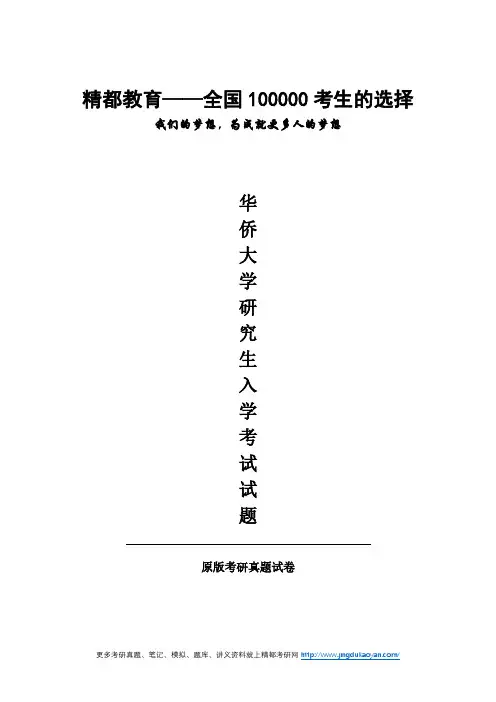
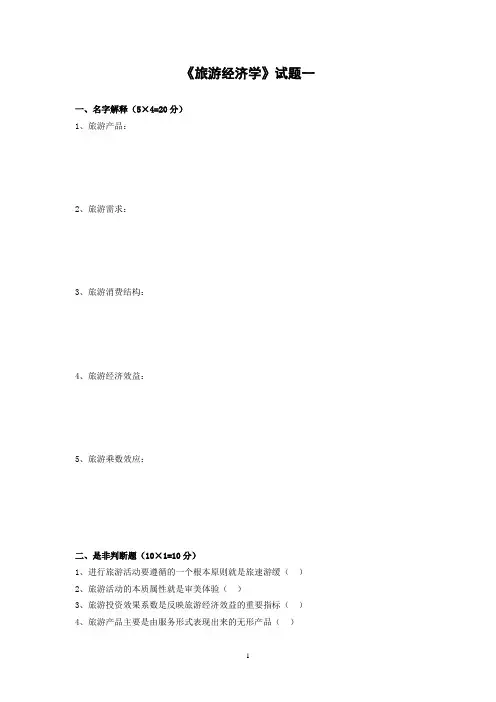
《旅游经济学》试题一一、名字解释(5×4=20分)1、旅游产品:2、旅游需求:3、旅游消费结构:4、旅游经济效益:5、旅游乘数效应:二、是非判断题(10×1=10分)1、进行旅游活动要遵循的一个根本原则就是旅速游缓()2、旅游活动的本质属性就是审美体验()3、旅游投资效果系数是反映旅游经济效益的重要指标()4、旅游产品主要是由服务形式表现出来的无形产品()5、旅游产品的消费需求弹性较大()6、旅游产品和旅游商品是同一概念()7、恩格尔系数与人们的生活水平成正相关()8、我国通常所说的旅游市场是指旅游客源市场()9、散客一般是指个人、家庭以及10人以下的自行结伴旅游者()10、旅游消费是一种低层次的消费形式()三、不定项选择题(10×2=20分)1、旅游经济学是一门()A、应用性学科B、经济学科C、边缘交叉学科D、基础性学科2、旅游产品是一种()A、整体性产品B、服务性产品C、动态性产品D、纯物质产品3、旅游环境容量包括()A、自然生态容量B、游客心理和生理容量C、社会环境容量D、经济环境容量4、旅游市场的特点主要表现为()A、多样性B、季节性C、波动性D、全球性5、衡量旅游消费效果的指标主要有()A、旅游消费总额B、人均消费额C、旅游消费率D、旅游消费构成6、根据旅游者消费水平可以将旅游市场划分为()A、豪华旅游市场B、标准旅游市场C、经济旅游市场D、廉价旅游市场7、旅游产品的非价格竞争主要是指()A、产品类型B、产品质量C、促销方法D、销售手段8、旅游市场开拓策略主要包括()A、无差异性市场策略B、差异性市场策略C、密集性市场策略D、集中性市场策略9、影响旅游价格形成的可控制因素包括()A、旅游产品成本B、旅游产品特色C、推销能力D、定价目标10、旅游收入按来源不同可以分为()A、国内旅游收入B、国际旅游收入C、商品性收入D、劳务性收入四、简答题(5×6=30分)1、旅游需求的产生条件有那些?2、我国入境旅游者消费结构呈现出哪些基本特征?3、从不同角度来划分,旅游市场可以分为哪些主要类型?4、提高旅游宏观经济效益的途径有哪些?5、影响旅游收入的主要因素有哪些?五、计算题(1×10=10分)某酒店拥有客房400间,全年分摊客房固定成本400万元,单位变动成本20元/间·天,预计全年出租率为80%,求该酒店客房出租的保本价格。
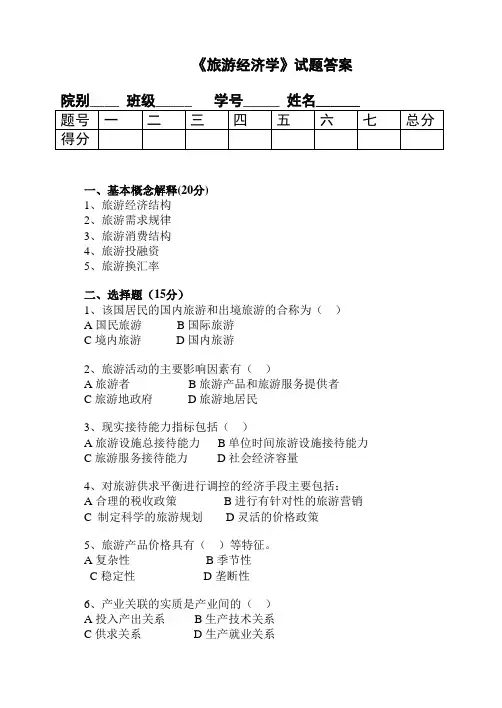
《旅游经济学》试题答案一、基本概念解释(20分)1、旅游经济结构2、旅游需求规律3、旅游消费结构4、旅游投融资5、旅游换汇率二、选择题(15分)1、该国居民的国内旅游和出境旅游的合称为()A国民旅游B国际旅游C境内旅游D国内旅游2、旅游活动的主要影响因素有()A旅游者B旅游产品和旅游服务提供者C旅游地政府D旅游地居民3、现实接待能力指标包括()A旅游设施总接待能力B单位时间旅游设施接待能力C旅游服务接待能力D社会经济容量4、对旅游供求平衡进行调控的经济手段主要包括:A合理的税收政策B进行有针对性的旅游营销C 制定科学的旅游规划D灵活的价格政策5、旅游产品价格具有()等特征。
A复杂性B季节性C稳定性D垄断性6、产业关联的实质是产业间的()A投入产出关系B生产技术关系C供求关系D生产就业关系7、反映一定时期内一个国家、一个地区居民出游频率常用的指标是()A旅游重游率B旅游消费率C旅游总出游率D旅游净出游率8、下列()属于旅游市场定性分析。
A指数平滑法B一元线性回归分析C二元线性回归分析D德尔菲法9、下列()是以竞争为中心的定价策略。
A随行就市法B区分需求定价法C理解价值定价法D成本导向定价法10、在最佳利润分析法中,当()时,企业获得最大利润。
A边际收入大于边际成本B边际收入小于边际成本C边际收入等于平均成本D边际收入等于边际成本11、某一产业在生产、产值、技术等方面发生变化所引起它下游产业部门的变化,属于()A后向关联效应B间接关联效应C前向关联效应D单项关联效应12、产业政策的本质是()对产业经济活动的主动干预。
A国家B企业C行业协会D法人团体13、当需求价格弹性系数大于1时,适当降低产品价格,收入会()A不变B提高C下降D不能确定14、按旅游融资过程中资金的来源分类,旅游融资方式可分为()。
A权益融资B内源融资C外源融资D债务融资15、目前产业融合从产业间或行业间的渗透或嵌入方式来看,可划分为()等几种类型A高新技术的渗透B产业间的延伸融合C政企间的延伸融合D产业内部的重组融合。
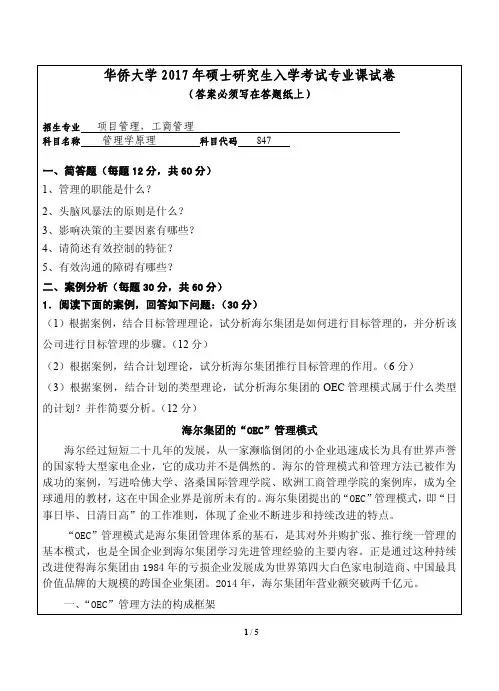
华侨大学2017年硕士研究生入学考试专业课试卷(答案必须写在答题纸上)招生专业项目管理,工商管理科目名称管理学原理科目代码847一、简答题(每题12分,共60分)1、管理的职能是什么?2、头脑风暴法的原则是什么?3、影响决策的主要因素有哪些?4、请简述有效控制的特征?5、有效沟通的障碍有哪些?二、案例分析(每题30分,共60分)1.阅读下面的案例,回答如下问题:(30分)(1)根据案例,结合目标管理理论,试分析海尔集团是如何进行目标管理的,并分析该公司进行目标管理的步骤。
(12分)(2)根据案例,结合计划理论,试分析海尔集团推行目标管理的作用。
(6分)(3)根据案例,结合计划的类型理论,试分析海尔集团的OEC管理模式属于什么类型的计划?并作简要分析。
(12分)海尔集团的“OEC”管理模式海尔经过短短二十几年的发展,从一家濒临倒闭的小企业迅速成长为具有世界声誉的国家特大型家电企业,它的成功并不是偶然的。
海尔的管理模式和管理方法已被作为成功的案例,写进哈佛大学、洛桑国际管理学院、欧洲工商管理学院的案例库,成为全球通用的教材,这在中国企业界是前所未有的。
海尔集团提出的“OEC”管理模式,即“日事日毕、日清日高”的工作准则,体现了企业不断进步和持续改进的特点。
“OEC”管理模式是海尔集团管理体系的基石,是其对外并购扩张、推行统一管理的基本模式,也是全国企业到海尔集团学习先进管理经验的主要内容。
正是通过这种持续改进使得海尔集团由1984年的亏损企业发展成为世界第四大白色家电制造商、中国最具价值品牌的大规模的跨国企业集团。
2014年,海尔集团年营业额突破两千亿元。
一、“OEC”管理方法的构成框架OEC是Overall Every Control and Clear的英文缩写,其含义是全方位地对每人、每天所做的每件事进行控制和清理,做到“日事日毕,日清日高”。
具体的讲,就是企业每天所有的事都有人管,控制到人不漏项;所有的人均有管理、控制的内容,并依据工作标准,按规定的计划执行。
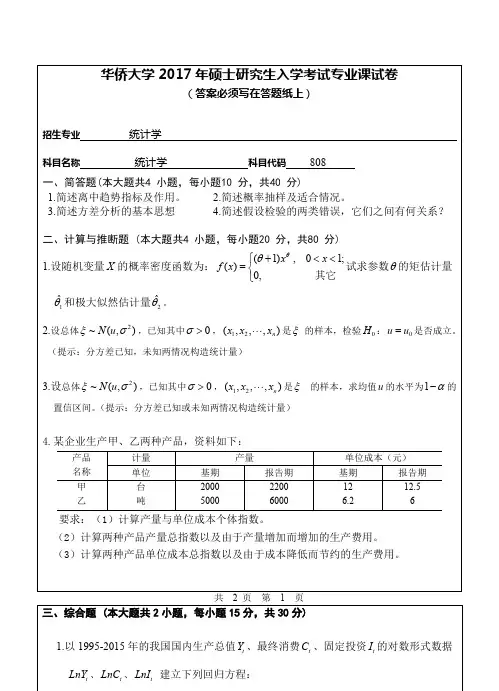
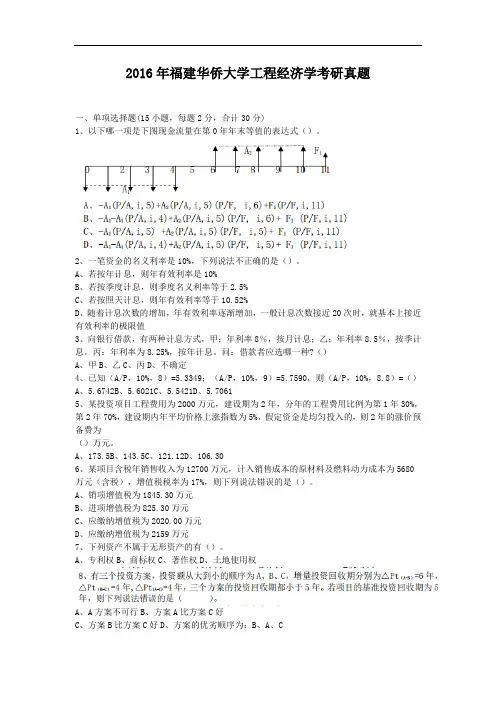
2016年福建华侨大学工程经济学考研真题一、单项选择题(15小题,每题2分,合计30分)1、以下哪一项是下图现金流量在第0年年末等值的表达式()。
2、一笔资金的名义利率是10%,下列说法不正确的是()。
A、若按年计息,则年有效利率是10%B、若按季度计息,则季度名义利率等于2.5%C、若按照天计息,则年有效利率等于10.52%D、随着计息次数的增加,年有效利率逐渐增加,一般计息次数接近20次时,就基本上接近有效利率的极限值3、向银行借款,有两种计息方式,甲:年利率8%,按月计息;乙:年利率8.5%,按季计息。
丙:年利率为8.25%,按年计息。
问:借款者应选哪一种?()A、甲B、乙C、丙D、不确定4、已知(A/P,10%,8)=5.3349;(A/P,10%,9)=5.7590,则(A/P,10%,8.8)=()A、5.6742B、5.6021C、5.5421D、5.70615、某投资项目工程费用为2000万元,建设期为2年,分年的工程费用比例为第1年30%,第2年70%,建设期内年平均价格上涨指数为5%,假定资金是均匀投入的,则2年的涨价预备费为()万元。
A、173.5B、143.5C、121.12D、106.306、某项目含税年销售收入为12700万元,计入销售成本的原材料及燃料动力成本为5680万元(含税),增值税税率为17%,则下列说法错误的是()。
A、销项增值税为1845.30万元B、进项增值税为825.30万元C、应缴纳增值税为2020.00万元D、应缴纳增值税为2159万元7、下列资产不属于无形资产的有()。
A、专利权B、商标权C、著作权D、土地使用权A、A方案不可行B、方案A比方案C好C、方案B比方案C好D、方案的优劣顺序为:B、A、C9、某项目现金流量图如下表所示,已知ic=10%,按照月度计息,则NPV为()。
A、580.26B、557.50C、1200D、745.1110、若某项目按基准折现率13%计算,所得的净现值为80万元,则该项目的内部收益率可能为()。
849华南理工大学2016 年攻读硕士学位研究生入学考试试卷(试卷上做答无效,请在答题纸上做答,试后本卷必须与答题纸一同交回)科目名称:旅游学适用专业:旅游管理共 3 页一、名词解释(每题5 分,共20 分)1. 惯常环境2. 休闲权力3. 旅游资源4. 旅游中介服务二、问答题(每题8 分,共32 分)1. 何谓愤怒指数?请说出这个概念的基本含义并举例说明。
2. 旅游决策一般可以分为哪几个阶段?说出每一阶段的基本特征。
3. 请根据改革开放以来中国国民旅游消费特征来分析国内旅游研究的发展特点。
4. 旅游的本质是什么?请以你自己的理解说明这个概念。
三、辨析题(10 分)2015 年1 月15 日,国家旅游局在江西南昌召开全国旅游工作会议,会议期间新履任的国家旅游局局长李金早作了一篇引起业界、学界广泛关注的报告,其中关于旅游六要素和新六要素的表述尤为引起诸多争议。
李金早博士认为,如今,激发人们旅游的动机和体验要素越来越多,需要拓展新的旅游要素。
吃、住、行、游、购、娱六要素为旅游基本要素,新的六要素“商、养、学、闲、情、奇”为旅游发展要素或拓展要素。
请问,你认同这种新六要素论吗?为什么?(注意:观点明确,阐述层次清晰)四、案例分析(每个案例15 分,共45 分)案例一M 饭店是西北某工业城市的一家三星级饭店,自1994 年开业以来,它一直惨淡经营,客房年均售出率不及40%,平均房价不足400 元,面临破产边缘。
M 饭店在投资兴建之前,该市已有5 家三星级饭店,近期还有7 家将建成。
而该市每年平均外来旅游者不足2 万人次,本地旅游资源匮乏,工业发展也不景气,商务客人很少。
由于没有足够客源支撑,饭店纷纷降价以吸引本地居民消费,但即使M 饭店推出18 元早餐也很少有人问津。
因此,M 饭店的客房主要靠低价来吸引省内地市县会议,但又造成一系列破坏性使用行为,致使客房成本居高不下,且维修费用极高。
M 饭店也尝试加大促销力度来吸引客源,但几番广告宣传过后,并未带来相应收获。
2017年华侨大学经济与金融学院西方经济学考研真题一、单项选择题(每小题2分,共40分)1.有两个股民,一个倾向于买业绩稳定的蓝筹股,另一个倾向于买创业板股票,则这两个股民在风险偏好方面的区别是()。
A.前者财富的效用大于财富的期望效用,后者财富的效用小于财富的期望效用B.前者是风险厌恶者,后者是风险中性者C.前者财富的边际效用大于1,后者财富的边际效用小于1D.前述区别均不正确2.如果某种商品提价10%,导致需求量减少15%,但供给量增加20%,则说明()。
A.消费者比生产者更在乎价格变化B.线性需求曲线斜率绝对值小于线性供给曲线斜率C.如果政府对生产者征收从量税,单位商品消费者税负大于生产者税负D.该商品的需求价格弹性小于需求交叉弹性3.设厂商面临的需求方程为Q=60-P,边际成本和平均成本为MC=AC=20,当产品销售价格P=20,则该厂商()。
A.若要增加销售收入应降价B.若要增加销售利润应提价C.若要增加生产者剩余应降价D.上述判断均不正确4.其他因素不变,下列哪个因素的变化将导致需求曲线的右移()。
A.生产要素价格下降B.消费者收入减少C.互补品价格下降D.替代品价格下降5.根据一般均衡的含义,当大米市场因自然因素导致大米供给减少,在其他因素不变下,将导致()。
A.小麦市场需求减少B.大米制品价格下降C.生产小麦的劳动工资提高D.面制品价格提高6.当面包生产者的短期边际成本SMC小于平均可变成本AVC,则()。
A.可变要素投入L还没有进入合理投入区间B.平均可变成本AVC处于上升阶段C.短期边际成本SMC处于上升阶段D.可变要素L的平均产量AP(L)处于下降阶段7.当物品具有非竞用性但有排他性时,则该物品属于()。
A.准公共物品B.纯公共物品C.共有资源D.私人物品8.下列哪种关系符合一种可变要素L的合理投入区间的要求()。
A.边际产量MP(L)大于平均产量AP(L)B.边际产量MP(L)处于下降阶段C.平均产量AP(L)处于下降阶段且总产量TP(L)处于上升阶段D.短期边际成本SMC处于上升阶段9.当不完全竞争厂商达到利润最大化产出时,存在着下列关系()。